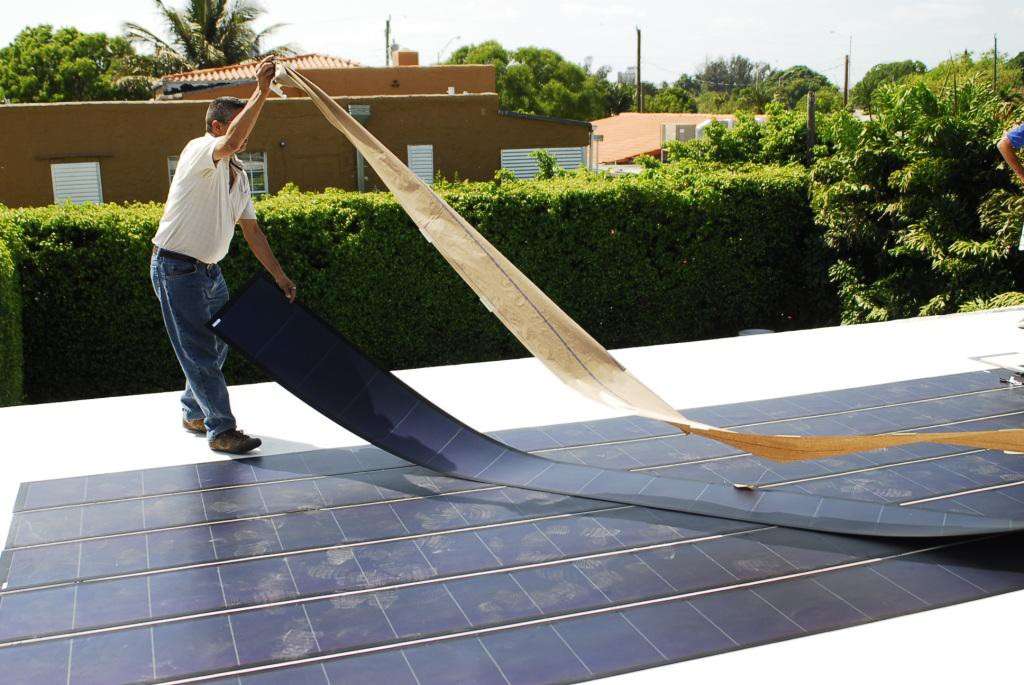The U.S. Department of Energy Solar Office supports innovative research focused on overcoming the current technological and commercial barriers for cadmium telluride (CdTe) solar cells. Below are a list of current projects, summary of the benefits, and discussion on the production and manufacturing techniques used for this solar technology
CdTe solar cells are the second most common photovoltaic (PV) technology in the world after mono-crystalline silicon cell currently representing 5% of the world market. CdTe thin-film solar cells can be manufactured quickly and inexpensively, providing an alternative to conventional silicon-based technologies. The record efficiency for a laboratory CdTe solar cell is 22.1% by First Solar. First Solar also reported its average commercial module efficiency to be approximately 18% at the end of 2020.
Thin-film photovoltaic (PV) devices based on CdTe absorbers represent one of the fastest growing segments of all PV technologies; it is even more remarkable that most of this impact has occurred within the past few years. Much of the reason for this rapid development can be traced to two facts: (1)thin-film PV modules have been designed specifically to embody production advantages over historic PV products (i.e., wafer-based technologies); and (2)CdTe PV modules and/or production processes presently embody some advantages over other thin-film technologies.


ADVANCES OF CADMIUM TELLURIDE (CDTE) THIN FILM PHOTOVOLTAIC CELLS
In the United States, scientists and manufacturers are working to expand production of cadmium telluride solar technology. Cadmium telluride (CdTe) is a type of “thin film” solar cell, and, as that name suggests, it’s much thinner than a traditional silicon cell. Today, panels using cadmium telluride supply about 40% of the U.S utility-scale market, and about 5% of the global solar market. And they stand to benefit from the headwinds facing the broader solar industry.
“It’s a very volatile time, especially for the crystalline silicon supply chain in general,” said Kelsey Goss, a solar research analyst for the energy consultancy group Wood Mackenzie. “There’s great potential for cadmium telluride (CdTe) manufacturers to take more market share in the coming year.” Especially, she noted, since the cadmium telluride sector is already scaling up.
Falling panel costs have driven the global solar boom. Over the last decade, the world’s total installed solar capacity has seen a nearly tenfold increase, from about 74,000 megawatts in 2011 to nearly 714,000 megawatts in 2020, according to the International Renewable Energy Agency. The United States accounts for about one-seventh of the world’s total, and solar is now one of the largest sources of new electricity capacity installed in the U.S. every year.
The cost per watt of cadmium telluride and other thin film technologies is similarly expected to shrink as manufacturing expands. (First Solar says that when its new Ohio facility opens, the company will deliver the lowest cost per watt on the entire solar market.) But cost isn’t the only metric that matters, as the industry’s current supply chain issues and labor concerns make clear.
Mark Widmar, CEO of First Solar, said the company’s planned $680 million expansion is part of a larger effort to build a self-sufficient supply chain and “decouple” the U.S. solar industry from China. Although cadmium telluride panels don’t use any poly-silicon, First Solar has felt other challenges facing the industry, like pandemic-induced backlogs in the maritime shipping industry.
In April, First Solar told investors that congestion at American ports was holding up panel shipments from its facilities in Asia. Increasing U.S. production will allow the company to use roads and railways to ship its panels, not cargo ships, Widmar said. And the company’s existing recycling program for its solar panels allows it to reuse materials many times over, further reducing its reliance on foreign supply chains and raw materials.
As First Solar churns out panels, scientists at both the company and NREL continue to test and improve cadmium telluride technology. In 2019, the partners developed a new approach that involves “doping” the thin film materials with copper and chlorine to achieve even higher efficiencies.
Earlier this month, NREL announced the results of a 25-year field test at its outdoor facility in Golden, Colorado. A 12-panel array of cadmium telluride panels was operating at 88 % original efficiency, a strong result for a panel that’s sat outside for over two decades. The degradation “is in line with what silicon systems do,” according to the NREL release.
CdTe solar cells are the second most common photovoltaic (PV) technology in the world marketplace after crystalline silicon, currently representing 5% of the world market. CdTe thin-film solar cells can be manufactured quickly and inexpensively, providing an alternative to conventional silicon-based technologies.
The record efficiency for a laboratory CdTe solar cell is 22.1% by First Solar. First Solar also reported its average commercial module efficiency to be approximately 18% at the end of 2020.


